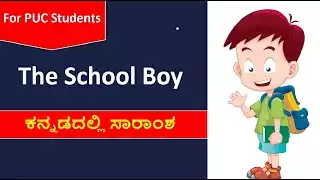About the poet:

William Blake was born on 28 November, 1757 in London. He was an English poet, painter and artist, who is regarded as a seminal figure of the Romantic age.
His well known books:
Poetical Sketches (1783) , Songs of Innocence (1789), Songs of Experience (1794), ‘The School Boy is a lyric from the Songs of Experience.
Summary in English:

Stanza 1: In the first stanza of the poem, the poet gives an imagination of the innocence nature. The speaker wished to wake early in the summer morning. The sound of the birds singing and the huntsman’s horn are both pleasant. He was attracted by the songs of skylark. He loves to entertain himself by the company of the innocence nature.
Stanza 2: According to the boy, a school is a place where all his happiness and joy pulls away. The words ‘cruel eye outworn’ refers to the authoritarian eyes of the teacher that actually tire the boy. The boy has to compulsorily attend the school, where he spends his day in boredom and dismay.
Stanza 3: In the school he felt unhappy and spends so many hours in anxious. He got tired with the rules of teachers and direct supervision on him. He don’t get happiness in his books and even through learning. Here ‘learning’s bower’ refers to a garden where the child can be taught in an interesting way.
Stanza 4: In the cage, a bird cannot sing. Because it is born for joy and happiness. Similarly, child if remained under the umbrella of annoying fear and tension, the skepticism of his teacher can never enjoy the natural instincts of joy and playfulness. He may forget the experience of youthful spring.
Stanza 5: In this stanza he tried to make understand his parents that if a child cannot get proper care then he could not grow like a natural plant. He argues that if misery withers the tender plants, the beautiful buds and the newborn buds, summer can never be joyful.
Stanza 6: The speaker says that a budding child is picked and swept off in the early stage of life in an ocean of sorrow , where there is no one to care. Its state is compared to damaged nature that can bear no fruit and have no harvest. It implies that if childhood pleasures and joys are censored , adult life runs the danger of being utterly dry and unproductive.
Summary in Kannada:
Stanza 1: ಕವಿತೆಯ ಮೊದಲ ಚರಣದಲ್ಲಿ, ಕವಿ ಮುಗ್ಧ ಸ್ವಭಾವದ ಕಲ್ಪನೆಯನ್ನು ನೀಡುತ್ತಾನೆ. ಸ್ಪೀಕರ್ ಬೇಸಿಗೆಯ ಬೆಳಿಗ್ಗೆ ಬೇಗನೆ ಏಳಲು ಬಯಸಿದರು. ಪಕ್ಷಿಗಳು ಹಾಡುವ ಶಬ್ದ ಮತ್ತು ಬೇಟೆಗಾರನ ಶಬ್ದ ಎರಡೂ ಆಹ್ಲಾದಕರವಾಗಿರುತ್ತದೆ. ಸ್ಕೈಲಾರ್ಕ್ ಹಾಡುಗಳಿಂದ ಅವರು ಆಕರ್ಷಿತರಾದರು. ಮುಗ್ಧತೆ ಸ್ವಭಾವದ ಒಡನಾಟದಿಂದ ಮನರಂಜನೆ ಪಡೆಯಲು ಅವನು ಇಷ್ಟಪಡುತ್ತಾನೆ.
Stanza 2: ಹುಡುಗನ ಪ್ರಕಾರ, ಶಾಲೆಯು ಅವನ ಎಲ್ಲಾ ಸಂತೋಷ ಮತ್ತು ಸಂತೋಷವನ್ನು ಎಳೆಯುವ ಸ್ಥಳವಾಗಿದೆ. ‘ಕ್ರೂರ ಕಣ್ಣು ಮೀರಿದೆ’ ಎಂಬ ಪದಗಳು ಶಿಕ್ಷಕನ ಸರ್ವಾಧಿಕಾರಿ ಕಣ್ಣುಗಳನ್ನು ಸೂಚಿಸುತ್ತದೆ, ಅದು ಹುಡುಗನನ್ನು ಸುಸ್ತಾಗಿಸುತ್ತದೆ. ಹುಡುಗನು ಶಾಲೆಗೆ ಕಡ್ಡಾಯವಾಗಿ ಹಾಜರಾಗಬೇಕು, ಅಲ್ಲಿ ಅವನು ತನ್ನ ದಿನವನ್ನು ಬೇಸರ ಮತ್ತು ನಿರಾಶೆಯಲ್ಲಿ ಕಳೆಯುತ್ತಾನೆ.
Stanza 3: ಶಾಲೆಯಲ್ಲಿ ಅವರು ಅತೃಪ್ತಿ ಹೊಂದಿದ್ದರು ಮತ್ತು ಹಲವು ಗಂಟೆಗಳ ಕಾಲ ಆತಂಕದಲ್ಲಿ ಕಳೆದರು. ಅವರು ಶಿಕ್ಷಕರ ನಿಯಮಗಳು ಮತ್ತು ಅವನ ಮೇಲೆ ನೇರ ಮೇಲ್ವಿಚಾರಣೆಯಿಂದ ಬೇಸತ್ತರು. ಅವನು ತನ್ನ ಪುಸ್ತಕಗಳಲ್ಲಿ ಮತ್ತು ಕಲಿಕೆಯ ಮೂಲಕವೂ ಸಂತೋಷವನ್ನು ಪಡೆಯುವುದಿಲ್ಲ. ಇಲ್ಲಿ ‘ಕಲಿಕೆಯ ಬೋವರ್’ ಎನ್ನುವುದು ಉದ್ಯಾನವನ್ನು ಸೂಚಿಸುತ್ತದೆ, ಅಲ್ಲಿ ಮಗುವಿಗೆ ಆಸಕ್ತಿದಾಯಕ ರೀತಿಯಲ್ಲಿ ಕಲಿಸಬಹುದು.
Stanza 4: ಪಂಜರದಲ್ಲಿ, ಒಂದು ಹಕ್ಕಿ ಹಾಡಲು ಸಾಧ್ಯವಿಲ್ಲ. ಏಕೆಂದರೆ ಇದು ಸಂತೋಷ ಮತ್ತು ಸಂತೋಷಕ್ಕಾಗಿ ಹುಟ್ಟಿದೆ. ಅದೇ ರೀತಿ, ಮಗು ಕಿರಿಕಿರಿ ಭಯ ಮತ್ತು ಉದ್ವೇಗದ ಛತ್ರದಲ್ಲಿ ಉಳಿದಿದ್ದರೆ, ಆತನ ಶಿಕ್ಷಕನ ಸಂದೇಹವು ಸಹಜವಾದ ಸಂತೋಷ ಮತ್ತು ತಮಾಷೆಯ ಸ್ವಭಾವವನ್ನು ಎಂದಿಗೂ ಆನಂದಿಸುವುದಿಲ್ಲ. ಅವನು ಯೌವನದ ವಸಂತದ ಅನುಭವವನ್ನು ಮರೆಯಬಹುದು.
Stanza 5: ಈ ಚರಣದಲ್ಲಿ ಅವನು ತನ್ನ ಹೆತ್ತವರನ್ನು ಅರ್ಥಮಾಡಿಕೊಳ್ಳಲು ಪ್ರಯತ್ನಿಸಿದನು, ಮಗುವಿಗೆ ಸರಿಯಾದ ಆರೈಕೆ ಸಿಗದಿದ್ದರೆ ಅವನು ನೈಸರ್ಗಿಕ ಸಸ್ಯದಂತೆ ಬೆಳೆಯಲು ಸಾಧ್ಯವಿಲ್ಲ. ನವಿರಾದ ಸಸ್ಯಗಳು, ಸುಂದರವಾದ ಮೊಗ್ಗುಗಳು ಮತ್ತು ನವಜಾತ ಮೊಗ್ಗುಗಳು ದುಃಖವು ಒಣಗಿದರೆ, ಬೇಸಿಗೆ ಎಂದಿಗೂ ಸಂತೋಷದಾಯಕವಾಗಿರುವುದಿಲ್ಲ ಎಂದು ಅವರು ವಾದಿಸುತ್ತಾರೆ.
Stanza 6: ಉದಯೋನ್ಮುಖ ಮಗುವನ್ನು ಜೀವನದ ಆರಂಭಿಕ ಹಂತದಲ್ಲಿ ದುಃಖದ ಸಾಗರದಲ್ಲಿ ಎತ್ತಿಕೊಂಡು ಹೋಗಲಾಗುತ್ತದೆ, ಅಲ್ಲಿ ಯಾರೂ ಕಾಳಜಿ ವಹಿಸುವುದಿಲ್ಲ ಎಂದು ಸ್ಪೀಕರ್ ಹೇಳುತ್ತಾರೆ. ಅದರ ಸ್ಥಿತಿಯನ್ನು ಹಾನಿಗೊಳಗಾದ ಪ್ರಕೃತಿಗೆ ಹೋಲಿಸಲಾಗುತ್ತದೆ ಅದು ಯಾವುದೇ ಫಲವನ್ನು ನೀಡುವುದಿಲ್ಲ ಮತ್ತು ಯಾವುದೇ ಸುಗ್ಗಿಯಿಲ್ಲ. ಬಾಲ್ಯದ ಸಂತೋಷಗಳು ಮತ್ತು ಸಂತೋಷಗಳನ್ನು ಸೆನ್ಸಾರ್ ಮಾಡಿದರೆ, ವಯಸ್ಕರ ಜೀವನವು ಸಂಪೂರ್ಣವಾಗಿ ಶುಷ್ಕ ಮತ್ತು ಉತ್ಪಾದಕವಲ್ಲದ ಅಪಾಯವನ್ನು ಎದುರಿಸುತ್ತಿದೆ ಎಂದು ಇದು ಸೂಚಿಸುತ್ತದೆ.
Watch this video for detailed explanation video. Click on the following video.